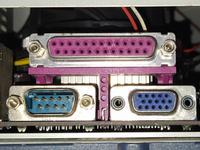RS232 Protocol: The Beginner's Guide
Placed onIt's easy to think that all communication in our modern world is wireless. But beneath the surface of wireless technologies is a world full of wires and connectors that streamline our technology infrastructure. One of the silent heroes of this world is the RS232 protocol. Although it has been in use for decades, RS232 remains one of the most reliable methods of data transfer.

History of RS232
The RS232 protocol, known in full as "Recommended Standard 232", was introduced in 1960 by the Electronic Industries Association (EIA) in the United States. This standard was developed to provide a common basis for transmitting serial binary data between devices such as computers, modems and other types of peripheral equipment.
The original RS232 protocol was capable of operating at data transfer rates of up to 20 kilobits per second, on a maximum cable length of 15 meters. It used a series of voltage signals to represent binary data, with positive voltages representing a binary 0 and negative voltages representing a binary 1.
In the following years, the RS232 standard was revised several times to keep up with changing technological needs. Despite the advent of newer, faster and more advanced communication protocols, RS232 has retained its relevance. It is still commonly used in a wide variety of applications, including industrial automation, telecommunications, scientific research, and more.
 Serial ports in a computer
Serial ports in a computer What is the advantage of RS232 over other protocols?
Many other communication protocols are available, such as RS422, RS485 and USB . While these newer protocols may be superior to RS232 in many ways (such as higher transfer rates or better noise immunity), RS232 has some key advantages:
- Simplicity: Compared to other protocols, RS232 is relatively easy to implement and understand. This can make it attractive to developers and engineers who need a reliable data communication solution quickly.
- Compatibility: RS232 is still widely supported in both older and some newer devices. This means that it is often the best or only choice for communication with certain types of hardware.
- Full Duplex Communication: Unlike RS485, which is half duplex, RS232 can support full duplex communication. This means that data can be sent and received simultaneously in both directions.
- Robustness: Although RS232 can be more sensitive to noise than RS422 or RS485, it is known for its reliability and robustness in a wide variety of applications and environments.
- Cost: The hardware required to establish an RS232 communication, such as cables and connectors, is generally cheaper than that for other protocols such as USB , RS422 or RS485.
- Resource Availability: Due to the long history of RS232, there are numerous tools and resources available to assist in the implementation and troubleshooting of this protocol.
The Basics of RS232
RS232 is a form of serial communication, which means that information is sent between devices one bit at a time. It is an asynchronous form of communication, which means that the sending and receiving devices can operate at different times.
The RS232 standard defines the details of how data is sent and received between devices. The main features of the RS232 standard are as follows:
- Voltage levels: RS232 communication uses voltage signals to represent binary data. A voltage between -3V and -15V represents a binary "1" (aka "Mark"), while a voltage between +3V and +15V represents a binary "0" (aka "Space").
- Data transmission: RS232 supports full duplex communication, which means that data can be sent and received in both directions at the same time.
- framing: Each data packet sent over RS232 contains a start bit, 5 to 9 data bits, an optional parity bit for error detection, and one or two stop bits. This structure is called a "frame".
- Baud rate: The baud rate is the number of signal changes per second that are sent or received over the line. In RS232, the baud rate is usually specified in bits per second (bps).
- Control lines: RS232 uses several control lines to manage the data flow between the transmitter and receiver. These include lines such as "Data Terminal Ready" (DTR), "Data Set Ready" (DSR), "Request To Send" (RTS), and "Clear To Send" (CTS).
- Parity check: This is a method of detecting errors in the transmitted data. Parity checking adds an extra bit (the parity bit) to each word of data (usually a byte), which is set to ensure that the total number of 1 bits in the word (including the parity bit) is always even or odd, depending on whether even or odd parity is used.
 RS232 protocol
RS232 protocol The RS232 serielecconnector
The RS232 connector is a kind of plug that we use to connect devices together using the RS232 protocol. The most famous version is the DE-9 or DB-9. This plug has 9 pins. There is also an older version with 25 pins, the DB-25, but it is less used.
But what if you have a device with such an RS232 connector, but your computer only has USB ports? Don't worry, there are special cables that solve this problem. These cables are called ' USB -to-serial adapters'. They change the data from the RS232 device so that it can go to your computer via a USB port. This allows you to still connect older devices that use an RS232 connector to newer computers that don't have RS232 ports.
- DFRobot MAX202 RS232 to TTL Converter For Arduino € 10,-
- Adafruit DE-9 (DB-9) Male Plug to Terminal Block Breakout € 3,75
- Pololu 23201a Serial Adapter Partial Kit € 11,90
- Adafruit DE-9 (DB-9) Female Socket Connector to Terminal Block Breakout € 3,75
- Pololu 23201a Serial Adapter Fully Assembled € 14,40
Applications of RS232
Despite its age, RS232 is still widely used in a wide variety of applications. It is often found in laboratory equipment, industrial machines, and some types of network equipment. While USB and Ethernet have become the standard for most consumer electronics, RS232 remains the go-to choice for many professional and industrial applications.
- Industrial automation: RS232 is often used for communication between various industrial machines and controllers, such as PLCs (Programmable Logic Controllers). It is also used for devices such as SCADA systems and HMI panels.
- Telecommunications: RS232 is used for communication between data communication equipment (DCE) and data terminal equipment (DTE), such as modems and routers.
- Laboratory equipment: Many laboratory instruments, such as spectrometers, use RS232 for data transfer and control.
- Point of Sale Systems: RS232 can be used in POS systems to control various components such as cash drawers and receipt printers.
- Medical equipment: Several medical devices, such as patient monitors and infusion pumps, use RS232 for data transmission.
- GPS systems: Many GPS devices use RS232 to transmit data to computers or other devices.
Easily control RS232 devices with these RS232 modules and shields
- In stock Opencircuit MAX3232 Mini RS232 to TTL converter € 1,45
- DFRobot MAX202 RS232 to TTL Converter For Arduino € 10,-
- Pololu 23201a Serial Adapter Partial Kit € 11,90
- Pololu 23201a Serial Adapter Fully Assembled € 14,40
- SparkFun Transceiver Breakout - MAX3232 € 9,60
- DFRobot RS232 Shield for Arduino € 12,25
Conclusion
Despite the rapid advancement of technology, RS232 continues to play an important role in the world of data communication. With its robustness, reliability and simplicity, it remains a valuable tool for anyone dealing with serial communication. Whether you are an engineer, a hobbyist or just curious, understanding RS232 can help you better understand how our technological world functions.









